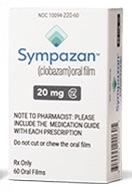Sympazan Disease Interactions
There are 3 disease interactions with Sympazan (clobazam).
Benzodiazepines (applies to Sympazan) acute alcohol intoxication
Major Potential Hazard, High plausibility.
The use of benzodiazepines with alcohol is not recommended. Patients with acute alcohol intoxication exhibit depressed vital signs. The central nervous system depressant effects of benzodiazepines may be additive with those of alcohol, and severe respiratory depression and death may occur. Therapy with benzodiazepines should be administered cautiously in patients who might be prone to acute alcohol intake.
References
- (2002) "Product Information. Xanax (alprazolam)." Pharmacia and Upjohn
- (2002) "Product Information. Valium (diazepam)." Roche Laboratories
- (2002) "Product Information. Ativan (lorazepam)." Wyeth-Ayerst Laboratories
- (2001) "Product Information. Serax (oxazepam)." Wyeth-Ayerst Laboratories
- (2001) "Product Information. Restoril (temazepam)." Sandoz Pharmaceuticals Corporation
- (2001) "Product Information. Halcion (triazolam)." Pharmacia and Upjohn
- (2001) "Product Information. Dalmane (flurazepam)." Roche Laboratories
- (2001) "Product Information. Tranxene (clorazepate)." Abbott Pharmaceutical
- (2001) "Product Information. Klonopin (clonazepam)." Roche Laboratories
- (2022) "Product Information. Prosom (estazolam)." Abbott Pharmaceutical
- (2001) "Product Information. Librium (chlordiazepoxide)." Roche Laboratories
- (2001) "Product Information. Doral (quazepam)." Wallace Laboratories
- (2001) "Product Information. Versed (midazolam)." Roche Laboratories
- (2011) "Product Information. Onfi (clobazam)." Lundbeck Inc
Benzodiazepines (applies to Sympazan) drug dependence
Major Potential Hazard, High plausibility. Applicable conditions: Drug Abuse/Dependence
Benzodiazepines have the potential to cause dependence and abuse. Tolerance as well as physical and psychological dependence can develop, particularly after prolonged use and/or excessive dosages. However, abrupt cessation following continual use of as few as 6 weeks at therapeutic levels has occasionally precipitated withdrawal symptoms. Addiction- prone individuals, such as those with a history of alcohol or substance abuse, should be under careful surveillance when treated with benzodiazepines. It may be prudent to refrain from dispensing large quantities of medication to these patients. After prolonged use or if dependency is suspected, withdrawal of benzodiazepine therapy should be undertaken gradually using a dosage- tapering schedule. If withdrawal symptoms occur, temporary reinstitution of benzodiazepines may be necessary.
References
- (2002) "Product Information. Xanax (alprazolam)." Pharmacia and Upjohn
- (2002) "Product Information. Valium (diazepam)." Roche Laboratories
- (2002) "Product Information. Ativan (lorazepam)." Wyeth-Ayerst Laboratories
- (2001) "Product Information. Serax (oxazepam)." Wyeth-Ayerst Laboratories
- (2001) "Product Information. Restoril (temazepam)." Sandoz Pharmaceuticals Corporation
- (2001) "Product Information. Halcion (triazolam)." Pharmacia and Upjohn
- (2001) "Product Information. Dalmane (flurazepam)." Roche Laboratories
- (2001) "Product Information. Tranxene (clorazepate)." Abbott Pharmaceutical
- (2001) "Product Information. Klonopin (clonazepam)." Roche Laboratories
- (2022) "Product Information. Prosom (estazolam)." Abbott Pharmaceutical
- (2001) "Product Information. Librium (chlordiazepoxide)." Roche Laboratories
- (2001) "Product Information. Doral (quazepam)." Wallace Laboratories
- (2011) "Product Information. Onfi (clobazam)." Lundbeck Inc
- (2020) "Product Information. Byfavo (remimazolam)." Acacia Pharma, Inc
Benzodiazepines (applies to Sympazan) depression
Moderate Potential Hazard, Moderate plausibility. Applicable conditions: Psychosis
Benzodiazepines depress the central nervous system and may cause or exacerbate mental depression and cause suicidal behavior and ideation. Episodes of mania and hypomania have also been reported in depressed patients treated with some of these agents. Therapy with benzodiazepines should be administered cautiously in patients with a history of depression or other psychiatric disorders. Patients should be monitored for any changes in mood or behavior. It may be prudent to refrain from dispensing large quantities of medication to these patients.
References
- (2002) "Product Information. Xanax (alprazolam)." Pharmacia and Upjohn
- (2002) "Product Information. Valium (diazepam)." Roche Laboratories
- (2002) "Product Information. Ativan (lorazepam)." Wyeth-Ayerst Laboratories
- (2001) "Product Information. Serax (oxazepam)." Wyeth-Ayerst Laboratories
- (2001) "Product Information. Restoril (temazepam)." Sandoz Pharmaceuticals Corporation
- (2001) "Product Information. Halcion (triazolam)." Pharmacia and Upjohn
- (2001) "Product Information. Dalmane (flurazepam)." Roche Laboratories
- (2001) "Product Information. Tranxene (clorazepate)." Abbott Pharmaceutical
- (2001) "Product Information. Klonopin (clonazepam)." Roche Laboratories
- (2022) "Product Information. Prosom (estazolam)." Abbott Pharmaceutical
- (2001) "Product Information. Librium (chlordiazepoxide)." Roche Laboratories
- (2001) "Product Information. Doral (quazepam)." Wallace Laboratories
- (2011) "Product Information. Onfi (clobazam)." Lundbeck Inc
Sympazan drug interactions
There are 514 drug interactions with Sympazan (clobazam).
Sympazan alcohol/food interactions
There is 1 alcohol/food interaction with Sympazan (clobazam).
More about Sympazan (clobazam)
- Sympazan consumer information
- Check interactions
- Compare alternatives
- Pricing & coupons
- Drug images
- Latest FDA alerts (3)
- Side effects
- Dosage information
- During pregnancy
- FDA approval history
- Drug class: benzodiazepine anticonvulsants
- Breastfeeding
- En español
Related treatment guides
Drug Interaction Classification
| Highly clinically significant. Avoid combinations; the risk of the interaction outweighs the benefit. | |
| Moderately clinically significant. Usually avoid combinations; use it only under special circumstances. | |
| Minimally clinically significant. Minimize risk; assess risk and consider an alternative drug, take steps to circumvent the interaction risk and/or institute a monitoring plan. | |
| No interaction information available. |
Further information
Always consult your healthcare provider to ensure the information displayed on this page applies to your personal circumstances.


